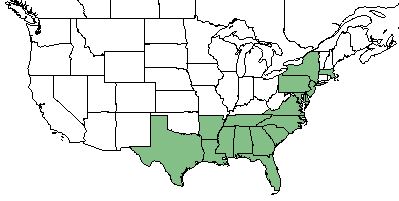Difference between revisions of "Magnolia virginiana"
(→Conservation and Management) |
|||
| Line 44: | Line 44: | ||
==Conservation and Management== | ==Conservation and Management== | ||
| + | ''M. virginiana'' is listed as endangered by the Massachusetts Division of Fisheries and Wildlife Natural Heritage and Endangered Species Program and the New York Department of Environmental Conservation Division of Land and Forests, and as threatened by the Pennsylvania Department of Conservation and Natural Resources and by the Tennessee Department of Environment and Conservation Natural Heritage Program. <ref name= "USDA Plant Database"/> | ||
==Cultivation and restoration== | ==Cultivation and restoration== | ||
Revision as of 15:18, 24 May 2018
| Magnolia virginiana | |
|---|---|

| |
| Photo by John B | |
| Scientific classification | |
| Kingdom: | Plantae |
| Division: | Magnoliophyta - Flowering plants |
| Class: | Magnoliopsida - Dicots |
| Order: | Magnoliales |
| Family: | Magnoliaceae |
| Genus: | Magnolia |
| Species: | M. virginiana |
| Binomial name | |
| Magnolia virginiana L. | |

| |
| Natural range of Magnolia virginiana from USDA NRCS Plants Database. | |
Contents
Taxonomic Notes
Synonyms: M. virginiana ssp. australis (Sargent) A.E. Murray
Varieties: none
Description
M. virginiana is a perennial shrub/tree of the Magnoliaceae family native to North America. [1]
Distribution
M. virginiana is found along the southeastern coast of the United States from Texas to Massachusetts. [1]
Ecology
Habitat
M. virginiana proliferates in pocosins, bay forests, and swamps in the Coastal Plain, streamhead pocosins, swamps, and sandhill seeps in the Sandhills, bogs and peaty swamps in the Piedmont and Mountains. [2]
Phenology
M. virginiana flowers April-June. [3]
Fire ecology
M. virigniana is fire resistant but has no fire tolerance. [1]
Use by animals
M. virginiana is highly palatable to browsing animals. [1]
Conservation and Management
M. virginiana is listed as endangered by the Massachusetts Division of Fisheries and Wildlife Natural Heritage and Endangered Species Program and the New York Department of Environmental Conservation Division of Land and Forests, and as threatened by the Pennsylvania Department of Conservation and Natural Resources and by the Tennessee Department of Environment and Conservation Natural Heritage Program. [1]
Cultivation and restoration
Photo Gallery
References and notes
- ↑ 1.0 1.1 1.2 1.3 1.4 USDA Plant Database https://plants.usda.gov/core/profile?symbol=MAVI2
- ↑ Weakley, A. S. (2015). Flora of the Southern and Mid-Atlantic States. Chapel Hill, NC, University of North Carolina Herbarium.
- ↑ PanFlora Author: Gil Nelson URL: http://www.gilnelson.com/PanFlora/ Date Accessed: 5/24/18